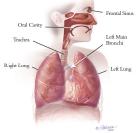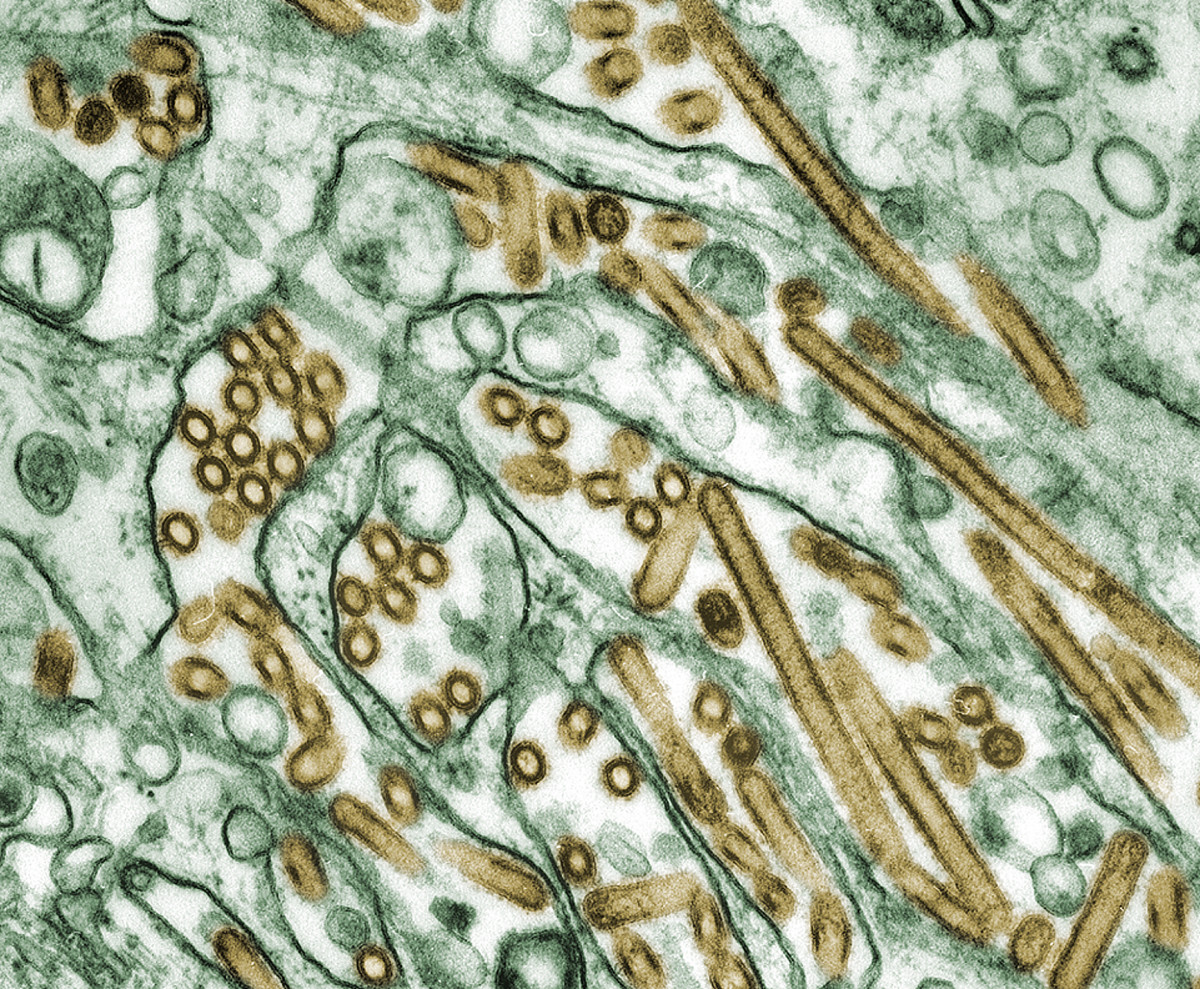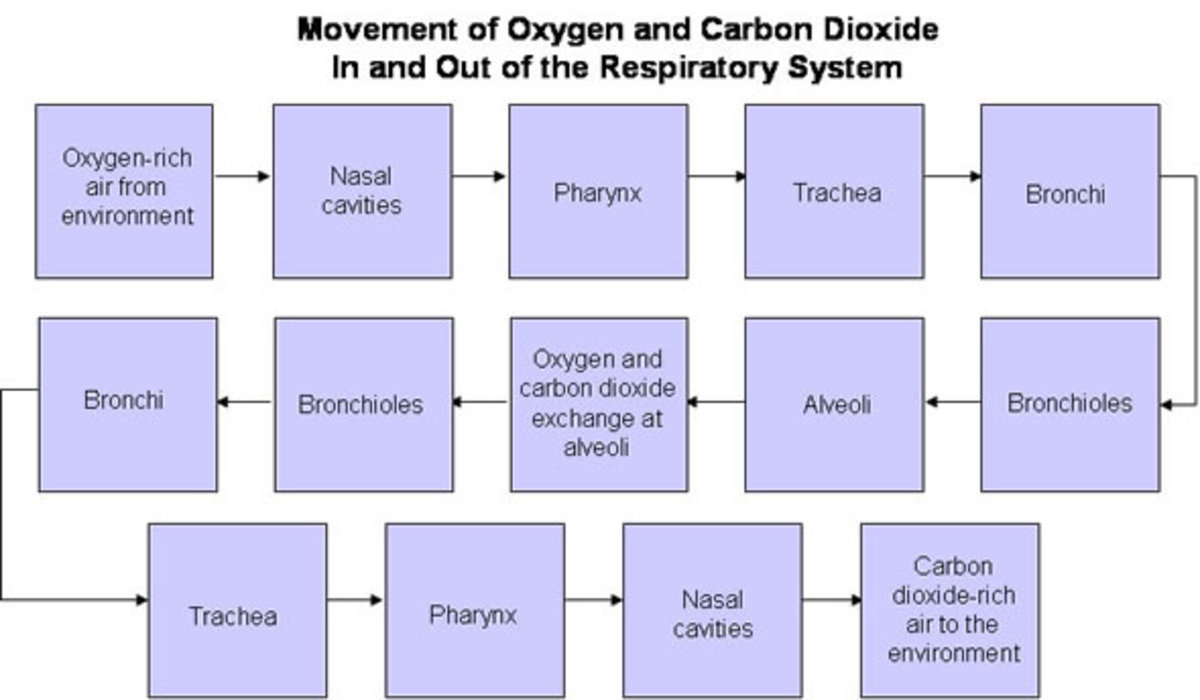Diseases and Disorders of the Respiratory System
The diseases of the respiratory system can affect any part of the respiratory tract and range from trivial to life-threatening. The nasal passages and pharynx are targets for the viruses membranes. The immune system fights back by increasing blood flow to the area, bringing numerous virus-attacking white blood cells to the scene; this cause the membranes to swell, resulting in the stuffy nose associated with colds. Mucous secretions increase in response to the viral attack, creating the runny nose typical of colds. The infection can spread to the sinuses, the membrane-line cavities in the head, as well as the lower respiratory tract and the middle ear.
The respiratory system is also subject to allergic reactions such as hay fever and asthma, brought about when the immune system is stimulated by pollen, dust, or other irritants. Hay fever is characterized by a runny nose, watery eyes, and sneezing. It usually occurs seasonally in response to abundant pollen in the air.
Asthma
Asthma is a breathing problem that makes it more difficult for a person to get air in and out of his lungs. When a person has asthma, the breathing tubes are sensitive. They may react to air pollution, smoke, pollen dust, allergies, or other triggers. The breathing tubes may tighten, becoming inflamed and swollen. That makes it harder for a person to breathe fresh in and exhale air out.
For many people, a tendency to asthma may be inherited. Other factors may also be involved such as smoking, allergies, and some medications can make asthma worse.
Acute Bronchitis
Acute bronchitis is an infection of the bronchial tree. The bronchial tree is made up of the tubes that carry air into the lungs. When these tubes get infected, they swell and mucus forms. This makes it hard for a person to breathe. The person may cough up mucus and many wheeze.
Acute bronchitis is almost always caused by viruses that attack the lining of the bronchial tree and cause infection. As the body fights back against these viruses, more swelling occurs and more mucus is made. It takes time for the body to kill the viruses and heal the damage to the bronchial tubes. In most cases, the same viruses that cause colds cause acute bronchitis. Bacterial infection is much less common in bronchitis. Very rarely, an infection caused by a fungus can cause acute bronchitis.
Emphysema
In emphysema the alveolar tissue partially destroyed and the remaining alveoli are weakened and enlarge. The bronchioles collapse on exhalation, trapping air in the alveoli. Over time this process impairs the ability to exchange oxygen and carbon dioxide with the circulatory system, leading to breathing difficulties; Emphysema is a noncontiguous disease that results from multiple factors, including a genetic predisposition to the condition, smog, cigarette smoke, and infection.
Laryngitis
Laryngitis, an inflammation of the larynx, is caused by a viral infection, irritants such as cigarette smoke, or by overuse of the voice. Laryngitis may cause hoarseness, or the voice may be reduced to a whisper until the inflammation subsides.
Lung Cancer
Lung cancer develops in individuals with a genetic predisposition to the disease who are exposed to cancer-causing agents, such as tobacco smoke, asbestos, and uranium. Cancerous tumors may start in the bronchi, bronchioles, or in the alveolar lung tissue. If lung cancer is detected before the cancer has spread to other parts of the body, treatments are more effective, and the prognosis for full recovery is good. Unfortunately, 85 percent of lung cancer cases are diagnosed after the cancer has spread, and for these cases, the prognosis is very poor.
Meningococcemia
Meningococcemia is the presence of meningococcus in the bloodstream. Meningococcus, a bacteria formally called Neisseria meningitidis, can be one of the most dramatic and rapidly fatal of all infectious diseases.
Meningococcemia, a relatively rare infection, occurs most commonly in children and young adults. In susceptible people, it can cause a very severe illness that can kill within hours. The bacteria, which can spread from person to person usually first causes a colonization in the upper airway, but no symptoms. From there, it can penetrate into the bloodstream to the central nervous system and cause meningitis or develop into a fullblown bloodstream infection (meningococcemia). Fortunately, in most colonized people, this does not happen and the result of this colonization is long-lasting immunity against the particular strain.
After colonization is established, symptoms can develop within one day to one to weeks. After a short period of time ( one hour up to two days) when the patient complains of fever and muscle aches, more severe symptoms can develop. Unfortunately, during this early stage, a doctor cannot tell this illness from any other illness, such as a viral infection like influenza. Unless the case is occurring in a person known to have been exposed to or in the midst of an epidemic of meningococcal disease, there may be no specific symptoms or signs found that help the doctor diagnose the problem. Rarely, a low-grade bloodstream infection called chronic meningococcemia can occur.
After this initial period, the patient will often complain of continued fever, shaking chills, overwhelming weakness, and even a feeling of impending doom. The organism is multiplying in the bloodstream, unchecked by the immune system. The severity of the illness and its dire complications are caused by the damage the organism does to the small blood vessell walls. This damage is called a vasculitis, inflammation of a blood vessell. Damage to the small vessels causes them to leak. The first signs of the infection's severity are small bleeding spots seen on the skin petechiae). A doctor should always suspect meningococcemia when he/she finds an acutely ill patient with fever, chills, and petechiae.
Within hours, the blood vessel damage increases and large bleeding areas on the skin (purpura) are seen. The same changes are taking place in the affected person's internal organ. The blood pressure is often blow and there may be signs of bleeding from other organs (like coughing blood, nose bleeds, blood in the urine). The organism not only damages the blood vessels by causing them to leak, but also causes clotting inside the vessels. If this clotting occurs in the larger arteries, it results in major tissue damage. Essentially, large areas of skin, muscle, and internal organs die from lack of blood and oxygen. Even if the disease is quickly diagnosed and treated, the patient has a high risk of dying.
Pertussis (Whooping Cough)
Pertussis is an infection of the respiratory tract caused by Bordetella Pertussis bacteria. This is a very contagious infection and can be quite serious. People become infected with Bordetella pertussis bacteria by inhealing contaminated droplets from an infected person's cough or sneeze. Once inside the airways, pertussis bacteria produce chemical substances (toxins) that interfere with the respiratory tract's normal ability to eliminate the germs. Pertussis bacteria also produce chemicals that cause inflammation, damaging the lining of the breathing passages.
Pleurisy
Pleurisy is an inflammation of the pleura (the lining of the lungs), with subsequent pain. This may develop in the presence of lung inflammable (pneumonia, tuberculosis), rheumatic diseases, chest asthma, certain cancers, and asbestos-related disease. The main symptom is pain over the chest wall at the site of the inflammation. In some circumstances, the pain may be felt in the shoulder. The pain is increased by deep breathing, coughing, and chest movement. The normal smooth pleural surfaces -roughened by inflammation - rub together with each breath, and may produce a rough, grating sound called a "friction rub." Fluid often accumulates at the site of pleural inflammation. A localized collection of fluid separates the lung pleura from the chest wall pleura, causing the chest pain to disappear even though the illness may be worsening.
Pneumonia
Pneumonia is an inflammation and infection of the lungs. Although pneumonia is special concern for older people and those with chronic illnesses, if can also strike young, healthy people as well.
In infectious pneumonia, bacteria, viruses, fungi or other organisms attack the lungs, leading to inflammation that makes it hard to breathe. Pneumonia can affect one or both lungs. Infection of both lungs is referred to as double pneumonia.
In many cases, pneumonia follows a common cold or the flu, but it also can be associated with other illnesses or occur on its own. Signs and symptoms of pneumonia vary greatly, depending on any underlying conditions the person may have and the type or organism causing the infection. Pneumonia can be cause by bacteria (like the Chlamydia), viruses, mycoplasma (tiny organism), fungi (like the Histoplasm acapsulatum) and Pneumocystis carinii (the most common opportunistic infection affecting Americans with AIDS).
Respiratory Distress Syndrome (RDS)
Respiratory Distress Syndrome (RDS) is the name for a cluster of symptoms that indicate severe malfunctioning of the lungs. In infants, RDS is termed Infant Respiratory Distress Syndrome (IRDS). Commonly found in premature infants, IRDS results when the alveoli fail to fully expand during inhalation. Expansion of the alveoli requires a chemical called surfactant, but in many premature infants, the alveoli are not developed enough to produce this vital substance. IRDS is treated by administering air and surfactant through a breathing tube until the alveoli begin producing surfactant on their own. Adult Respiratory Distress Syndrome (ARDS) results when lungs are severely injured, for example, in an automobile accident, by poisonous gases, or as a response to inflammation in the lungs. ARDS is a life-threatening condition with a survival rate of about 50 percent.
Severe Acute Respiratory Syndrome (SARS)
Severe acute respiratory syndrome (SARS) is a vital respiratory illness caused by a coronavirus, called SARS-associated coronavirus (SARS-CoV). SARS was first reported in Asia in February 2003. Over the next few months, the illness spread to more than two dozen countries in North America, Europe, and Asia before the SARS global outbreak of 2003 was contained.
SARS begins with a high fever (temperature greater than 100.4°F [>38.0°C]). Other symptoms may include headache, an overall feeling of discomfort, and body aches. Some people also have mild respiratory symptoms at the outset. About 10 percent to 20 percent of patients have diarrhea. After 2 to 7 days, SARS patients may develop a dry cough. Most patients develop pneumonia.
The main way that SARs seems to spread is by close person-to-person contact. The virus that causes SARS is thought to be transmitted most readily by respiratory droplets (droplet spread) produced when an infected person coughs or sneezes. Droplet spread can happen when droplets from the cough or sneeze of an infected person are propelled a short distance (generally up to 3 feet) through the air and deposited on the mucous membranes of the mouth, nose, or eyes of persons who are nearby. The virus also can spread when a person touches a surface of object contaminated with infectious droplets and then touches his or her mouth, nose, or eye(s). In addition, it is possible that the SARS virus might spread more broadly through the air (airborne spread) or by other ways that are not now known).
Tuberculosis
Tuberculosis is caused by a bacterium that attacks the lungs and sometimes other body tissues as well. If infections in the lungs are left untreated, the disease destroys lung tissue. In the past, antibiotics have controlled tuberculosis, but recently, new antibiotic-resistant strains of the tuberculosis bacterium have evolved. These new strains now pose a significant public health problem.






